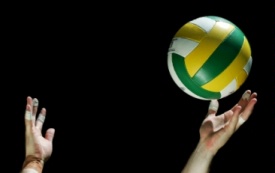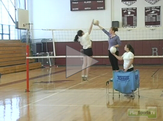Individual Volleyball Skill Work Makes a Difference

Individual drills and skill work are important even in a team sport like volleyball
By Craig Haley
PSTV Managing Editor
Betty Wroubel has coached basketball and softball in addition to her first love as an award-winning high school volleyball coach. Unlike basketball and softball, she considers volleyball to be one of the hardest sports to practice individually because of its nature as team competition.
But, Wroubel says, there is great reason to practice volleyball skills individually. Players who do, says Wroubel, one of the co-recipients of the first American Volleyball Coaches Association National High School Coach of the Year award in 2007 – after her Notre Dame Preparatory School volleyball program won a school-record 54 wins and its first Michigan state title – refine just enough skills to make a difference when playing with teammates.
“In basketball, I can get a rebound, dribble down and shoot and do it all myself. I can’t do that in volleyball,” Wroubel says. “You have to have teamwork, so 95 percent of your work is going to be with a team and working with other kids versus individual. But to make your individual skills better so that that teamwork works out – you can be a better team member – you need some of that individual stuff, too.”
Wroubel recommends that coaches not overload boys’ and girls’ volleyball players with individual drills, but to stress small amounts of work on their own.
The best individual work often involves the volleyball serve. Players can work on serve accuracy either by hitting off a wall or over a net and into a targeted area.
“I look at what we need to work on with that athlete and then try to design something,” says Wroubel, a volleyball coach for over 30 years. “So if their footwork is the problem, I may have them toss the ball against the wall and then when it bounces coming back off have them work on their footwork. Go get it. That way, put a target on the wall, so they’re focusing and aiming at a target and can focus on the footwork. We’ll put tape on the floor of how we want their feet to go to the ball.
“Obviously, serving to targets, I use everything I can find, whether they’re small carpets in the hallway or Hula Hoops, you get different points for hitting different targets.”
Wroubel recommends that setters practice hitting to a higher target – she puts a cart on top of a volleyball official’s stand – to improve placing the volleyball at both a certain height and area. The players also will gain a better feel for how the ball comes off their fingertips.
Youth volleyball players don’t even have to hit the ball to develop as players, Wroubel adds. She recommends youngsters practice throwing the ball off different parts of the net to learn how the ball rebounds off it. And youngsters will benefit if they simulate their dives and rolls, learning how to fall while hitting the volleyball. “The younger age actually the better for them,” Wroubel says, “because they don’t have as great of a fear as the high school students tend to.”
The majority of volleyball skills involve teamwork, but one of the nation’s top high school coaches says even the smallest amount of individual work will be a difference maker.




